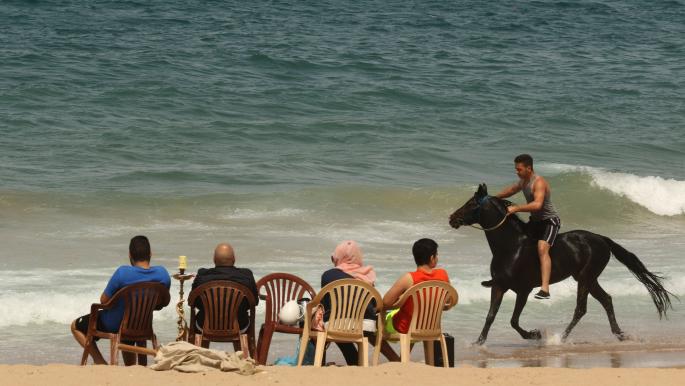The receding of the waters of the Mediterranean… A natural tidal movement that is not frightening
Over the past few days, social media pioneers have shared pictures and videos showing a significant decline in the water level of the Mediterranean Sea in a number of countries. As some of the tweeters linked this phenomenon to the two earthquakes on Monday, the sixth of this month, in southern Turkey and northern Syria, questions arose about the truth of the matter, which raised residents’ fears of tsunamis that might hit the countries of the Mediterranean basin, especially with the continued recording of frequent aftershocks in the region.
In Lebanon, videos spread showing the water receding in front of the sea castle in the city of Sidon (south of the country), and its surroundings appeared barren, prompting some to comment that the sea castle of Sidon has become wild, according to the (official) National News Agency. Pictures of the receding sea water in the Adloun region (south) and the appearance of cracks in the rocks of one of the beaches also caused a sensation in the country. Others published pictures of the receding waters in Turkey and on the Syrian coast, especially in Latakia and Tartous, as well as in Palestine at the shores of some cities such as Gaza and Acre. In Egypt, publications talked about the receding of sea water at the shores of North Sinai Governorate, which sparked terror. In Libya, residents of the city of Benghazi circulated videos showing sea water retreating to unprecedented distances. In Algeria, pictures of the decline of sea water on the country’s coast spread. The same is the case off several Tunisian beaches, as tweeters circulated videos fearing that the sea would turn into a desert. And news emerged of a severe decrease in the water level in some of the famous canals of the Italian city of Venice.
tide
The director of the National Center for Marine Sciences affiliated to the National Council for Scientific Research in Lebanon, Milad Fakhri, explains to Al-Araby Al-Jadeed that “the sea has returned to its normal course, and the water level has risen again,” saying, “It is a natural, not frightening tidal movement that occurs every day and every day.” A month and every year.Sometimes it is strong and sometimes it is lighter, and currently the period of tides is strong, and maybe it is stronger than in non-years, but it is related to the cycle of years and natural factors.The movement of the tides is linked to the moon, and perhaps the gravity of the moon is stronger during this period and the position of the planets is parallel and closer to the earth.So the strong tides occurred All over the eastern basin of the Mediterranean, bearing in mind that in Lebanon, for example, we witnessed with a number of fishermen, sailors and coastal residents such a phenomenon about 10 or 20 years ago, but at that time pictures and videos were not spread, as is the case today on social media. To the public after the earthquake in Turkey and Syria, and the accompanying terror in the hearts of the people, and the clear weather and the absence of rain and storms allowed them to go out and photograph and understand the matter, especially in the shallow areas of shallow depth and at the ports, where the pain recedes. Oh, more.”
He explains that “the maximum tidal days in Lebanon, for example, occur during the month of February of each year, but they differ from one country to another in the eastern basin of the Mediterranean, noting that the tidal movement is weak in the Mediterranean, and the natural receding of the water ranges between 40 and 50 centimeters.” If it is exceeded, it is not the end of the world.In Lebanon, for example, the tides usually range between 30 and 40 centimeters as a maximum, while Tunisia is the country in which the strongest tidal movement occurs among the countries of the Mediterranean basin, and it reaches 50 centimeters. But it is important to know that the water receding 40 or 50 centimeters does not show the same scene in all countries and even within one country, according to the depth and topography of each beach.When the sea level in Libya decreases, for example, by 40 or 50 centimeters, the receding appears at 500 meters, as some have reported. Pioneers of social networking sites, and this appears especially in the sloping and shallow areas with little depth, while in Turkey, the water receded to 40 centimeters.”
Fakhri reassures people, saying: “There is no tsunami, earthquake, volcano, or crater that draws water, because the sea is already full of valleys and holes. The important thing is that no abnormal movement of faults occurs from an earthquake or strong tremor in the sea, and this possibility exists wherever it is around the world and causes a tsunami, knowing that Our sea is closed, and the impact of a tsunami, if it occurs, will be lighter. The tidal movement is very strong in the oceans, and there are places where boats become without water, as the sea sometimes recedes tens of meters, as in the Saint-Michel region in France.”
Venice
Regarding the controversy over the severe decline of water in Venice, Fakhri reveals that “it is not the first time that the city of Venice (Venice) has suffered from drought. Rather, it happened in 2018, at the present time, and perhaps before that.” And he talks about many and accumulated factors that led to the sharp drop in the water level in Venice, among them “limited rainfall, tidal movement, and high atmospheric pressure that led to stronger tidal movement and lowering of the water surface. The decline of the Mediterranean waters also has an impact, of course, as the issue is not It is only related to the decline in the rate of feeding the canals from the rivers. It is worth noting that the current drought may be followed by floods in Venice in the next fall or winter, as happens sometimes, but we do not necessarily witness floods immediately after this receding.
And the agency “Reuters” had revealed that “the water level in the famous canals of Venice has declined exceptionally to become dry,” speaking of “fears that Italy might face another drought after the state of emergency last summer, as the Alps witnessed less than half the rate of precipitation.” Usual snow, according to scientists and environmental movements. The agency added: “The city of Venice, which has always been a preoccupation with floods, today is witnessing an unusually low water level, making it impossible for gondolas, water taxis and ambulances to navigate some of its famous canals.” On the suffering of Italian rivers and lakes from severe water shortages, especially in the north of the country. Reuters quoted the Italian newspaper, Corriere della Sera, as saying, “We are in a state of water deficit that has been accumulating since the winter of 2020-2021.” We need to recover 500 millimeters of water in the northwestern regions, and for that we need 50 days of rain.”
no fear
For his part, Imad Saud, a specialist in marine sciences at the American University of Beirut, reveals that “his initial scientific observations of the sea did not indicate a significant decline, bearing in mind that talking about a phenomenon outside the context of tides requires 24-hour monitoring and research to resolve matters, not just capturing And he publishes pictures and videos at high tide, that is, when the water recedes only.” He says, “It is a matter of tides at a rate of 90 percent, but it happened that there were winds and low atmospheric pressure on the average, which led to the withdrawal of water. The tidal movement is a natural movement that occurs every year, and has nothing to do with tsunamis. When the sea recedes, if there is a tsunami, it returns higher than It was within ten minutes or half an hour maximum after the receding.In our case today, that did not happen, but it receded for more than an hour and returned naturally with a regular wave.The tides also get stronger and lower every month, and they are stronger with the full moon.The tides get every The eastern basin of the Mediterranean, and returns after three hours, and coincides with the movement of the moon.
Saud points out that “the countries located north of the equator, including the countries of the Mediterranean basin, usually witness the largest difference between the tides, i.e. the highest and lowest tides in the month of June of each year, while the movement is less in the month of December.” December and it starts to rise every month. But the occurrence of this phenomenon in February is not scary. When the moon, the earth and the sun are in a straight line, we witness a lot of tides.” He continues: “Sometimes many factors come together at the same time, so the tides are at their maximum in the case of low atmospheric pressure in the western region of Turkey, for example, and it coincides with winds that strike the northern or eastern side. The low atmospheric pressure pulls water, the wind pushes water, and the tides pull water. And if Each led to the withdrawal of five centimeters from the water level, we are witnessing a receding of about 15 to 20 centimeters and land appears.”
It has nothing to do with climate change
Saud stresses that “there is no scientific reason to show that the phenomenon of sea water receding is linked to the earthquakes in Turkey and Syria, and there is no relationship whatsoever between them.” He says: “There will be no tsunami, and there will be no crater that swallows water, as is the case, and the water retreat has nothing to do with climate change, as the latter causes a rise in sea level rather than a decline, since we are witnessing the melting of ice in the Arctic. As for volcanoes, about 99 percent of them are under water.” There are more than a thousand volcanoes around the world that have been operating on a daily basis at the bottom of the seas for billions of years, so there is no fear of a volcano coming to us.”
He recalls that “the Mediterranean Sea has not witnessed a new tsunami for millions of years. For example, the Sea of Lebanon, as it is today, is too small to witness tsunamis. If it occurs, the wave length will be between 300 to 500 kilometers at a speed that exceeds the speed of a jet plane, noting that the regular wave that hits the coast of Lebanon is as long as it is.” Between 80 and 150 metres.In the event that an earthquake occurs 10 kilometers from the Lebanese coast, the wave will be so small that it does not cause a rise in the waters at the level of Lebanon, but it may pose a danger to Italy, as the wave is 500 kilometers long, and the Lebanese cannot see it. 10% of it, and then the wave height in Lebanon reaches half a meter as a maximum, and it is not considered a tsunami, while if the strong earthquake occurred in Italy, we will see a large tsunami in Lebanon, noting that 90% will hit Cyprus before reaching Lebanon.In short, Beirut will not sink if a strong earthquake occurs close to it.For the tsunami wave to be high and dangerous to Beirut, it must be preceded by an earthquake that is 300 kilometers or more away from Beirut.And the fault that was said to have caused the last two earthquakes 10 kilometers from the Lebanese capital, It may cause an earthquake that may destroy Beirut, but it does not cause a tsunami. The same reality applies to other countries.” He concludes, “The faults do not affect the level of the Mediterranean waters, and they have nothing to do with the tides. And what we are witnessing in Venice is also due to drought, as a result of the lack of rain for a while.”


